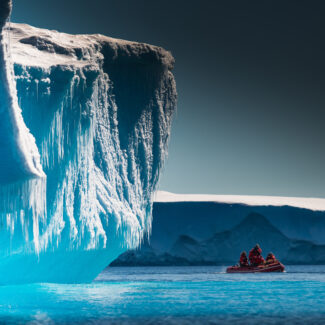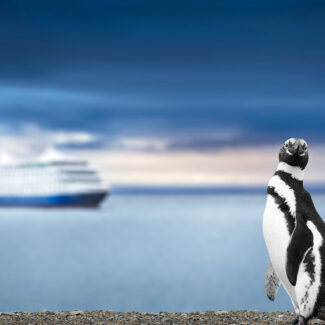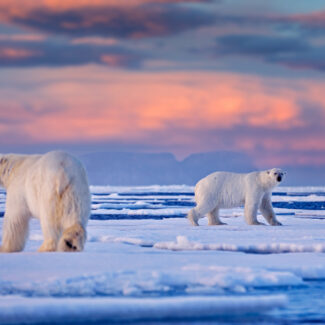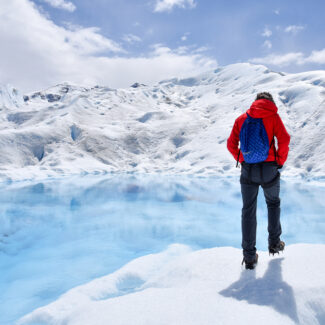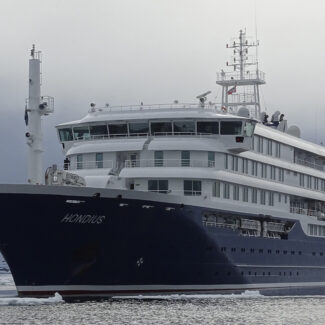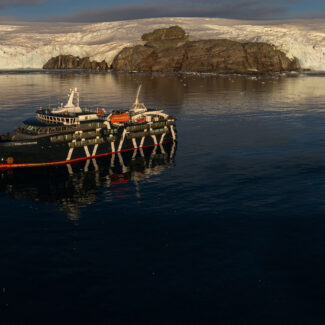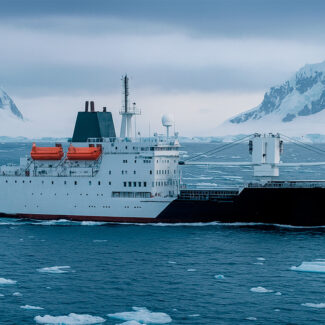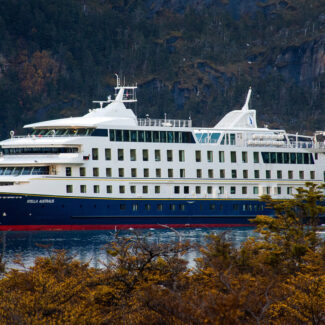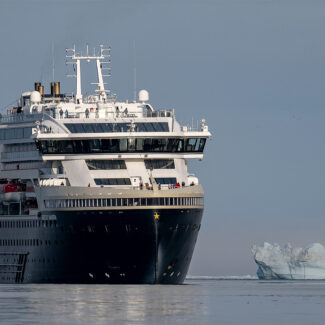The Best Places To Visit In The Arctic
- Where To Go In Greenland: The Top 3 Places To Visit
- (1) West Greenland: The Ilulissat Icefjord & Disko Bay
- (2) South Greenland: Prins Christian Sund & Kujataa
- (3) East Greenland: Scoresby Sund, Northeast Greenland National Park, & Ittoqqortoormiit
- Where To Go In Iceland: The Top 4 Places To Visit
- (1) Vatnajökull National Park
- (2) The Westfjords
- (3) Vestmannaeyjar (Westman Islands)
- (4) North Iceland: Húsavík & Akureyri
- Where To Go In Svalbard: The Top 3 Places To Visit
- Where To Go In The Canadian Arctic & Northwest Passage: The Top 4 Places To Visit
- The North Pole
- Experience The Best Of The Arctic On A Cruise
The Arctic is, of course, a vast territory, stretching in circumpolar fashion around the very crown of our planet. And much of it is breathtakingly remote.
Despite the farflung nature of this geography, its wonders—glaciers and icebergs, polar bears and walruses, the shimmering Midnight Sun and the pulsing Northern Lights—can be seen firsthand on one of our Arctic cruise expeditions.
Ah, but where to go? What are the best places to visit in the Arctic Circle? It’s a nearly impossible question to answer, given how enormous and varied this region is and the fact that different travelers are interested in different subjects and activities. But we’ve given it a go in the following roundup!
We’ll stress up front that we’re restricting our list of destinations to our primary cruise routes, and thus excluding, for example, Alaska—which we do visit at the tail-end of our Northwest Passage tours—and the Russian Arctic. We’ve thus arranged our best places to visit in the Arctic by the following regions: Greenland, Iceland (which is technically just below the Arctic Circle), Svalbard, the Canadian Arctic (including the Northwest Passage), and the North Pole, which constitutes its own standalone “best place.”
Where To Go In Greenland: The Top 3 Places To Visit
The biggest island in the world and host to the only remaining ice sheet in the Northern Hemisphere, Greenland also includes the northernmost tierra firme in the Arctic, an incredible lineup of wildlife, and a fascinating blend of Norse/Viking archaeology and deep-rooted, still-vital Inuit culture.
(1) West Greenland: The Ilulissat Icefjord & Disko Bay
Greenland’s most-visited destination lies along its southwestern coast: the Baffin Bay arm of Bahía de Disko and one of its tributary waterways—the celebrated Ilulissat Icefjord, a UNESCO World Heritage Site. The Icefjord comes well-named, cluttered with brash ice and sculptured icebergs calved off Sermeq Kujalleq, an outlet glacier draining the Greenland Ice Cap and one of the fastest-moving icestreams on Earth. Icebergs also raft into the ethereal expanse of Disko Bay, regularly plied by great whales and seals.
(2) South Greenland: Prins Christian Sund & Kujataa
Linking the Labrador and Irminger seas and separating the far southern coast of mainland Greenland from the Cape Farewell Archipelago, the roughly 60-mile-long Prins Christian Sund (Ikerasassuaq) forms one of the sightseeing glories of South Greenland, edged as it is by soaring mountains, bold promontories, and tidewater glaciers. Sails through this jaw-dropping waterway—part of a region sometimes called “Arctic Patagonia”—get you up-close to the monumental scenery, and may turn up sightings of marine mammals (along with rafting icebergs).
The UNESCO World Heritage Site complex of Kujataa, meanwhile, comprises five remarkable sites preserving farming settlements of the Greenlandic Norse as well as more recent Inuit agriculture and animal husbandry. From the farmsteads of Qassiarsuk, the most extensive pastoral landscape in Greenland, and the manor ruins of Igaliku, lorded over by the signal peak Illerfissalik, to the farms and shielings of Tasikuluulik—called Vatnahuerfi, the “Lake District,” by Norse—Kujataa showcases some of the country’s most significant archaeological and cultural treasures.
None is more famous than the Hvalsey Church, part of Kujataa’s Qaqortukulooq component, set near the head of a fjord containing the namesake island of Hvalsey (“Whale Island”). This expertly built ashlar-fieldstone church, the design of which suggests a probable 14th-century vintage, is the best-preserved Norse site in Greenland, a relic, like its associated farmstead, of the Greenlandic Norse “Eastern Settlement.” The name of the nearby town of Qaqortoq means “white,” which is possibly a reference to the prominently situated church’s formerly whitewashed appearance. A 1408 wedding held at Hvalsey Church provided the last written documentation of Greenland’s Norse presence.
(3) East Greenland: Scoresby Sund, Northeast Greenland National Park, & Ittoqqortoormiit
East Greenland is the wilder side of the giant island, and cruisegoers here experience some of the most spectacular and unique land- and seascapes in the Arctic. You’ll find, for instance, the biggest fjord system on the planet: Scoresby Sund, which runs some 220 miles (350 kilometers) from its multi-armed head to its mouth in the Greenland Sea. Glaciers such as the Daugaardi-Jensen generate icebergs that float down its waterway, while soaring ramparts create a breathtaking backdrop.
And due north of Scoresby Sund sprawls the world’s largest and northernmost national park: Parque Nacional del Noreste de Groenlandia, the 375,000 square miles (972,000 square kilometers) of which include a big swath of the Greenland Ice Cap—covering a solid majority of the park—as well as a dramatically rugged coastline and the farthest-north ground on Earth in Peary Land. The scenery and pristineness alone are reason enough to cruise this wild oceanfront, but the icing on the cake comes with the chance to spot marvelous Arctic beasts such as polar bears, muskoxen, Greenland wolves, and a diverse roster of marine mammals.
Another highlight of the East Greenland coast is the colorful hamlet of Ittoqqortoormiit, among the most isolated towns anywhere and boasting a truly magnificent setting close to the mouth of Scoresby Sund.
Where To Go In Iceland: The Top 4 Places To Visit
Lying just south of the Arctic Circle, Iceland sits astride the great spreading tectonic frontier of the Mid-Atlantic Ridge, marking the only above-sea-level exposure of that geologically volatile fissure. The result is an abundance of active volcanoes and some of the world’s densest concentrations of geysers and other geothermal features. Rich Viking lore, stunning scenery that ranges from verdant to glacial, and a distinctive, fun- and wellness-loving culture—plus the famously vibrant and welcoming capital city of Reykjavic—make this Land of Fire and Ice a must-visit cruise destination. Here are some of the top sights!
(1) Vatnajökull National Park
Unfurling across close to 15,000 square kilometers (5,792 square miles) of southeastern Iceland, Vatnajökull National Park protects some of the most spectacular—and dynamic—landscapes in the world. This UNESCO World Heritage Site is dominated by the great Vatnajökull Icecap, which covers about seven percent of Iceland’s land area and overlies no fewer than seven active subglacial volcanoes, including Öræfajökull, whose summit rim includes Hvannadalshnjükur, the 2,110-meter (6,920-foot) crown of the island. The ice domes and outlet glaciers of Vatnajökull—not to mention the iceberg-spiked glacial lagoons of Jökulsárlón and Fjallsárlon and the park’s ethereal outwash (sandur) plains—make for epic sightseeing, and world-class hiking abounds.
(2) The Westfjords
Forming the less-touristed northwestern reach of Iceland, the Westfjords (Fiordos del Oeste) are increasingly on the globetrotter map given their scenic splendor, alluring remoteness, and rich natural heritage. Here you’ll find the biggest bird cliff in Europe, Látrabjarg, used by better than a million nesting seabirds, puffins and razorbills among them. The far northwest of the Westfjords encompasses the uninhabited peninsula of Hornstrandir, host to striking cliffs and no small number of Arctic foxes (Iceland’s sole native land mammal). And then there’s the incredible, stairstep waterfall complex of Dynjandi…
(3) Vestmannaeyjar (Westman Islands)
The cliffy islands, islets, sea stacks, and skerries of the Westman Islands are another Icelandic jewel, and, without question, one of the best birdwatching destinations in the world. After all, the islands play host to the biggest rookery of Atlantic puffins on the planet. Puffin season here runs from April to August or September, and provides outstanding opportunities for cruisegoers to see these universally beloved “parrots of the sea.” A slew of other seabird species—guillemots, storm-petrels, skuas, and others—as well as whalewatching potential only enhance the appeal of Vestmannaeyjar for ecotourists.
(4) North Iceland: Húsavík & Akureyri
Journey to North Iceland and visit the “Capital of the North,” Akureyri, the country’s second-biggest city and a gateway to some of the chief sights of the Diamond Circle Sightseeing Route. Excursions to astonishing Lake Myvatn—home to the Earth Lagoon Myvatn/Myvatn Nature Baths and other geothermal features—and the famous “Waterfall of the Gods,” Goðafoss, whose thunderous whitewater horseshoe spans roughly 100 feet (30 meters), are unforgettable.
And then there’s Húsavík, Iceland’s oldest settlement, which serves as a stellar springboard for the excellent whalewatching available in Skjálfandi Bay, where everything from orcas and white-beaked dolphins to humpbacks and the biggest animal on the planet, the blue whale, cruise.
Where To Go In Svalbard: The Top 3 Places To Visit
The Norwegian Arctic archipelago of Svalbard—the biggest island of which is Spitsbergen, the “Wildlife Capital of the Arctic”—is a wonderland of mountains, sea cliffs, ice, and megafauna. One of the best places on the planet to see polar bears, these islands serve up a heady dose of Far North wilderness.
(1) Austvonna
Composing about a third of Svalbard’s entire volume of glacial ice, Austvonna on Nordhaustlandet—the second-biggest of the archipelago’s islands, situated in the northeast—ranks as the third-largest icecap in Europe. Fed by snowfall mainly generated by precipitation off the Barents Sea, Austvonna looms to a main ice dome of about 800 meters (2,624 feet) in elevation, and it forms some of Svalbard’s most mesmerizing vistas—not least in late summer and early fall, part of prime cruise season here, when meltwater plunges off the icecap into the ocean via towering waterfalls. Besides the otherworldly ice ramparts and their cascades, cruises to Austvonna sometimes yield sightings of polar bears and other marine mammals.
(2) Alkefjellet Bird Cliffs
The soaring coastal scarp of Alkefjellet, which encompasses sheer walls rearing some 100 meters (330 feet) and sharp pinnacles that overlook Hinlopen Strait, would be a top-tier Svalbard attraction based on geomorphology alone. The fact that this constitutes one of the Arctic’s great bird cliffs—host to tens of thousands of guillemots (the name translates to “Mountain of the Guillemots”) as well as kittiwakes and gulls—ups the ante even more. Meltwater streamers often plunge off the dolerite faces, and Arctic foxes—drawn, naturally, by the seasonal abundance of eggs and nestlings—are not uncommonly spied.
(3) Magdalenefjorden
Among the most awe-inspiring fjords in the archipelago, Magdalenefjorden creates a sublime cut along Spitsbergen’s western coast, edging the bay called Gullybukta as well as the glacial front of Waggonwaybren. The fjord includes the historic whaling site of Trinity Port, on Graves Headland (Gravneset), where lies a cemetery housing graves of 17th- and 18th-century vintage. Wildlife-watching is also excellent here, with the possibility of spotting one of those “ice bears” for which Svalbard’s so celebrated.
Where To Go In The Canadian Arctic & Northwest Passage: The Top 4 Places To Visit
The Far North of Canada includes the most extensive land area above the Arctic Circle, much of it manifesting as the wonderfully convoluted and ravishingly beautiful Canadian Arctic Archipelago. Long home to Inuit peoples, this realm long drew the interest of outsiders intrigued by the prospect of a “Northwest Passage” linking the North Atlantic and the North Pacific.
(1) Baffin Island
Canada’s biggest island—and one of the biggest in the world—507,451-square-kilometer (195,928-square-mile) Isla de Baffin is the giant of the Arctic Archipelago, and one of the most scenic, culturally rich, and history-drenched corners of the entire Arctic. Here you’ll find the capital of Nunavut, Iqaluit, the northernmost city in Canada, as well as the celebrated Inuit settlement of Pangnirtung, aka “Pang,” whose monumental setting has given it the nickname “the Switzerland of the Arctic.” Pang’s also a gateway to sprawling and remote Auquittug National Park, set on the Cumberland Peninsula and host to the Penny Icecap and some truly stunning peaks of the Baffin Mountains: the towering half-dome of Mount Thor, for example, which boasts arguably Earth’s grandest cliff-face, and the double pillars of Mount Asgard. The park is also an epic place for wildlife-watching, host as it is to everything from wolves and polar bears to narwhals and belugas (which find globally significant wintering range in Baffin Bay).
Other highlights of the region include the huge fjord of Admiralty Inlet and the showstoppingly scenic—and almost entirely protected (Sirmilik National Park)—Bylot Island just off Baffin Island’s northern coast, a polar-bear hotspot.
(2) Somerset Island
Set in the heart of the Canadian Arctic Archipelago and the Northwest Passage, Somerset Island was named by William Edward Parry in 1819, and it offers fascinating history. Port Leopold marks where James Clark Ross and his party overwintered in 1848 while searching for the vanished Franklin Expedition, while the final trading post installed by the Hudson’s Bay Company, established in 1937, can be seen at Fort Ross on the Bellot Strait. In the southeast of the island, meanwhile, Elwin Bay (Ikpiarjuk) is a wildlife hub, a good place to look for polar bears and harboring numerous beluga whales in Cunningham Inlet during the summer.
(3) Gjoa Haven
The sole settlement on King William Island, Gjoa Haven marks the site where, in its harbor, iconic Norwegian explorer Roald Amundsen and his small party aboard the Gjøa spent two winters during their successful transit of the Northwest Passage—the first documented of its kind—from 1903 to 1906. That’s not all that’ll appeal to history buffs here: This Inuit community is also right on the doorstep of the icy waters concealing the resting places of the Franklin Expedition’s foundered vessels, only discovered in the 2010s and protected near Gjoa Haven as the Wrecks of the HMS Erebus y HMS Terror National Historic Site (which isn’t open to the public).
(4) Ellesmere Island
The most northerly and rugged island in the Arctic Archipelago, fjord-indented Ellesmere constitutes deep polar wilderness. It includes Canada’s northernmost land—Cape Columbia—and extensive ice caps and even ice shelves, though these are rapidly diminishing. The loftiest mountains in all of eastern North America are found in the Arctic Cordillera ranges of Ellesmere Island, topping out on the 2,616-meter (8,583-foot) summit of Barbeau Peak. That striking, ice-swaddled cone falls within Quttinirpaaq (“Top of the World”) National Park, which encompasses much of Ellesmere Island and harbors Arctic wolves, muskoxen, Peary caribou, polar bears, Arctic hares, snowy owls, and other wildlife. Ellesmere is separated from Greenland to the east by the Nares Strait, which in places is only a dozen or so miles across.
View our Canadian Arctic Cruises >
View our Northwest Passage Cruises >
The North Pole
A cruise to the Polo Norte Geográfico—the quest for which compelled some of the last great feats of exploration in the late 19th and early 20th centuries—is unforgettable, putting you in the footsteps of truly legendary Arctic explorers such as Cook, Peary, Amundsen, Herbert, and Fiennes. The chance to visit this true Top of the World, set amid the ever-shifting sea ice of the Arctic Ocean, is a top-tier High Arctic adventure defined by deliciously remote polar seas, the potential for thrilling wildlife encounters, and the undeniably special feeling of visiting a notable geographic extreme relatively few people will ever see for their own eyes.
Experience The Best Of The Arctic On A Cruise
From the bird cliffs of Svalbard to the beluga hangouts of the Canadian High Arctic, from the Norse ruins of Greenland to the Inuit outposts of Nunavut, we can introduce you to the natural and cultural wonders of the Arctic firsthand. Explore all of our Arctic cruise options today!
Descargo de responsabilidad
Nuestras guías de viaje tienen únicamente fines informativos. Si bien nuestro objetivo es proporcionar información precisa y actualizada, Antarctica Cruises no hace ninguna representación en cuanto a la exactitud o integridad de cualquier información en nuestras guías o encontrado siguiendo cualquier enlace en este sitio.
Antarctica Cruises no puede y no aceptará responsabilidad por cualquier omisión o inexactitud, o por cualquier consecuencia derivada de ello, incluyendo cualquier pérdida, lesión o daño resultante de la visualización o uso de esta información.



